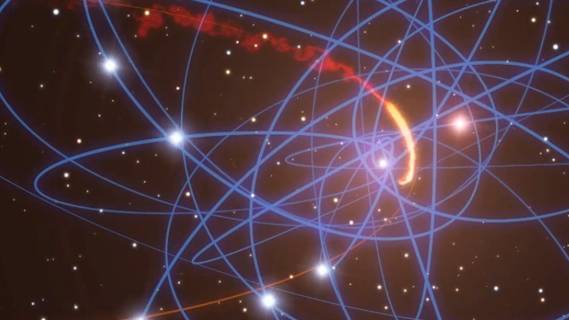Countdown to a black hole show
Source: cosmiclog.msnbc.msn.com
Researchers are watching the first scenes of a cosmic show that’s expected to heat up over the next year as a giant gas cloud approaches the supermassive black hole at the center of our galaxy.
The impending collision was the subject of a research paper published in Nature last December, and now Youris.com, the European Research Media Center, is providing an update: By mid-2013, the cloud is expected to pass in the vicinity of the black hole, known as Sagittarius A*, at a distance of 36 light-hours, or less than 25 billion miles (40 billion kilometers).
Black holes are gravitational singularities so dense that nothing, not even light, can escape their grip. They can only be detected by their gravitational influence on their surroundings, or by the blazing swirl of material being sucked down into their maw.
Some black holes are thought to be created when massive stars collapse. Others, like Sagittarius A*, are thought to be crushed into existence as part of the galaxy formation process. Sagittarius A* is 4.3 million times as massive as our sun, and is located 27,000 light-years from our solar system. There’s no danger that this black hole will gobble up the galaxy — in fact, it’s unusually well-behaved, which is one reason why humanity has been able to hang around long enough to detect it.
Stefan Gillessen, an astrophysicist at Germany’s Max Planck Institute for Extraterrestrial Physics, has been observing Sagittarius A* for the past 20 years. He says next year’s encounter could provide an unprecedented view of our supermassive black hole at its best ... or at its worst.
"So far, there were only two stars that came that close to Sagittarius A*," Youris.com quotes him as saying. "They passed unharmed, but this time will be different: The gas cloud will be completely ripped apart by the tidal forces of the black hole."
Astronomers at the European Southern Observatory say the speed of the cloud’s progress has nearly doubled over the past seven years, to more than 5 million mph (8 million kilometers per hour). They report that the cloud’s edges are already beginning to shred. During the months to come, it should break up into elongated filaments. "It will look like spaghetti," Gillessen said.
The cloud is also expected to get much hotter, and will probably start emitting X-rays.
Reinhard Genzel, who heads the ESO’s team of astronomers, said the show won’t end with next year’s expected encounter.
"The next few years will be really fantastic and exciting, because we’re probing the territory," he said in the Youris.com video report. "Here this cloud comes in, gets disrupted, but now it will begin to interact with the hot gas right around the black hole. We have never seen this before."
Source: cosmiclog.msnbc.msn.com






















